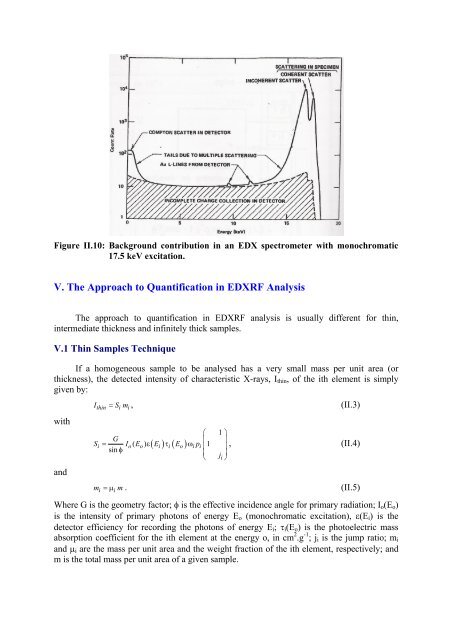X-Ray Fluorescence Analytical Techniques - CNSTN : Centre ...
X-Ray Fluorescence Analytical Techniques - CNSTN : Centre ...
X-Ray Fluorescence Analytical Techniques - CNSTN : Centre ...
You also want an ePaper? Increase the reach of your titles
YUMPU automatically turns print PDFs into web optimized ePapers that Google loves.
Figure II.10: Background contribution in an EDX spectrometer with monochromatic<br />
17.5 keV excitation.<br />
V. The Approach to Quantification in EDXRF Analysis<br />
The approach to quantification in EDXRF analysis is usually different for thin,<br />
intermediate thickness and infinitely thick samples.<br />
V.1 Thin Samples Technique<br />
If a homogeneous sample to be analysed has a very small mass per unit area (or<br />
thickness), the detected intensity of characteristic X-rays, Ithin, of the ith element is simply<br />
given by:<br />
with<br />
and<br />
Ithin = Sm i i , (II.3)<br />
⎛ 1 ⎞<br />
G<br />
⎜ ⎟<br />
Si = Io( Eo) ε( Ei) τi( Eo) ωipi 1<br />
sin φ ⎜ ⎟<br />
⎜ j ⎟<br />
⎝ i ⎠<br />
, (II.4)<br />
mi =µ i m.<br />
(II.5)<br />
Where G is the geometry factor; φ is the effective incidence angle for primary radiation; Io(Eo)<br />
is the intensity of primary photons of energy Eo (monochromatic excitation), ε(Ei) is the<br />
detector efficiency for recording the photons of energy Ei; τi(Eo) is the photoelectric mass<br />
absorption coefficient for the ith element at the energy o, in cm 2 .g -1 ; ji is the jump ratio; mi<br />
and µi are the mass per unit area and the weight fraction of the ith element, respectively; and<br />
m is the total mass per unit area of a given sample.


